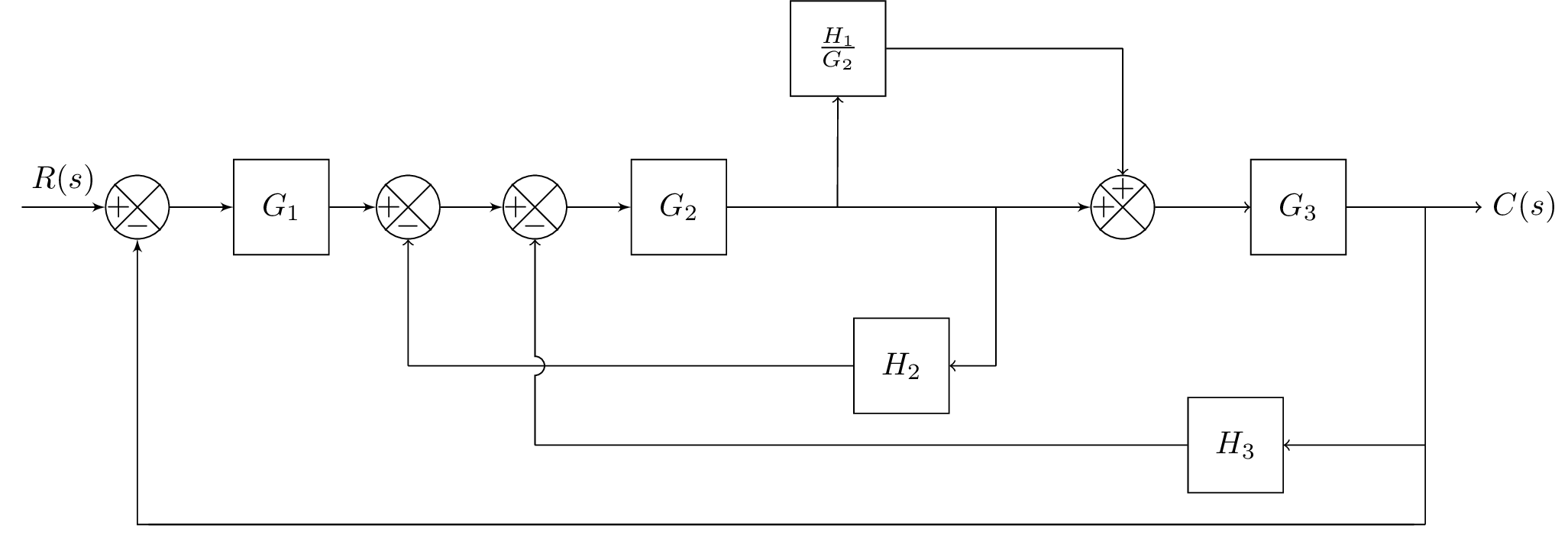Description
The Laplace transform of a signal is defined as .
In this block diagram, represents the Laplace transform of the reference input signal, , , and represent the transfer functions of the systems, and , , and represent the transfer functions of the feedback paths.
The block diagram can be represented mathematically as:
The signal flow through the diagram is as follows: The reference input is fed to the summing junction where it is added to the feedback signal to produce the error signal. The error signal is then fed through the transfer function to produce the output signal .
The feedback signal is also fed through the transfer function and then added to the output of . The resulting signal is then fed through the transfer function and subtracted from the error signal at the summing junction.
Keywords
tikz, nodes, arrows, styles, positioning, shapes.
Source Code

% standalone diagram for block diagrams
\documentclass{standalone}
\usepackage{blox}
\usepackage{tikz}
\usetikzlibrary{positioning}
\newcommand{\equal}{=}
\usepackage{tikz}
\usetikzlibrary{intersections}
\usepackage{tkz-euclide}
% Radius for arc over intersection
\def\radius{1.mm}
\tikzset{
connect/.style args={(#1) to (#2) over (#3) by #4}{
insert path={
let \p1=($(#1)-(#3)$), \n1={veclen(\x1,\y1)},
\n2={atan2(\y1,\x1)}, \n3={abs(#4)}, \n4={#4>0 ?180:-180} in
(#1) -- ($(#1)!\n1-\n3!(#3)$)
arc (\n2:\n2+\n4:\n3) -- (#2)
}
},
}
\begin{document}
\begin{tikzpicture}
\bXInput{A} % Input
\bXComp{B}{A} % First adder
\bXLink[$R(s)$]{A}{B} % Input Label
\bXBloc[2]{C}{$G_1$}{B} % Block G1
\bXLink{B}{C} % First added -- G1
\bXComp{D}{C} % Second adder
\bXComp{E}{D} % Third adder
\bXBloc[2]{G2}{$G_2$}{E} % Block G2
\bXBranchx[5]{G2}{G2Right} % Branch for H1, G2
\bXBranchy[-5]{G2Right}{invG2H1Left} % node before 1 /G2
\bXBloc[-1.5]{invG2H1}{$\frac{H_1}{G_2}$}{invG2H1Left} % Block 1/G2
\bXBranchx[-3.5]{invG2H1}{invG2H1left} % Branch for H1, G2
\bXBranchx[10]{G2}{Bran2} % Branch after G2 and for H2
\bXBranchy[5]{Bran2}{Bran2Down} % beneath branch 2
\bXBloc[-4.5]{H2Block}{$H_2$}{Bran2Down}
\bXSuma{adder4}{Bran2}
\bXLink{C}{D}
\bXLink{D}{E}
\bXLink{E}{G2}
\bXLink{G2}{adder4} % G2 to adder
\bXBloc[3]{G3Block}{$G_3$}{adder4} % G3
\bXBranchx[4]{G3Block}{BranEnd} % branch before output
\bXBranchy[7.5]{BranEnd}{H3BlockRight} % Right H3 Block
\bXBranchy[2.5]{H3BlockRight}{BranEndReturn} % Right H3 Block
\bXBranchy[7.5]{E}{adder3down} % Below adder3
\bXBloc[-7.5]{H3Block}{$H_3$}{H3BlockRight} % H3 Block
\draw[-] (BranEnd.center) -- (H3BlockRight.center);
\draw[->] (H3BlockRight.center) -- (H3Block);
\draw[-] (H3BlockRight.center) -- (BranEndReturn.center);
\bXBranchy[10]{B}{adder1Down}
\draw[-] (BranEndReturn.center) -- (adder1Down);
\bXBranchy[5]{D}{adder2down} % beneath adder2
\bXBranchy[-5]{adder4}{adder4up} % beneath adder4
%\bXLinkyx{EH1.center}{H2} % -- Connection for branch 1 and H1
\draw[->] (G2Right.center) -- (invG2H1);
%\draw[->] (invG2) -- (H1);
\draw[->] (Bran2Down.center) -- (H2Block);
\draw[-] (Bran2Down.center) -- (Bran2.center);
\draw[-,name path=H2 to adder2down] (H2Block) -- (adder2down.center); % used in intersection
\draw[->] (adder2down.center) -- (D);
\draw[-] (invG2H1) -- (adder4up.center);
\draw[->] (adder4up.center) -- (adder4);
\draw[->] (adder4) -- (G3Block);
\node[right = 0.5cm of BranEnd] (end) {$C(s)$};
\draw[->] (G3Block) -- (end);
\draw[-] (H3Block) -- (adder3down.center);
\path[name path=line] (adder3down.center) -- (E);
\path[name intersections={of=H2 to adder2down and line,by=inter}];
\draw[->,connect=(adder3down.center) to (E) over (inter) by 3pt ];
\bXLinkxy{BranEndReturn}{B}
\end{tikzpicture}
\end{document}